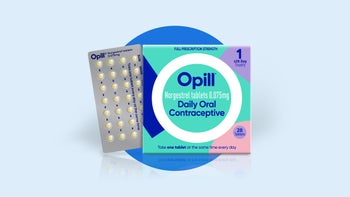
How Much Does Opill Cost?
Key takeaways:
Opill (norgestrel), the first over-the-counter birth control pill approved by the FDA, became available to customers on retail shelves and online in March 2024. You can access the daily oral medication without a prescription, which expands access to contraception in the U.S.
Depending on the supply you choose, Opill can cost about $15 to $20 a month. A 28-pill pack costs $19.99 or less, and an 84-pill pack costs about $49.99. A manufacturer assistance program can provide Opill at little to no cost for qualified, uninsured consumers with low incomes. You can buy the 84-pill pack and the 168-pill pack directly through GoodRx with free shipping.
However, if you have health insurance or use a GoodRx coupon, birth control accessed with a prescription can cost less than Opill. Under the Affordable Care Act, most health insurance plans cover birth control pills as preventive care with no out-of-pocket costs. You may be able to pay for Opill with funds from a health savings account (HSA) or flexible spending account (FSA).
Access savings on related medications
Table of contents

Birth control pills are available over the counter (OTC) in more than 100 countries, according to Free the Pill, a coalition of organizations that advocates for increased access to birth control pills — including OTC availability.
Beginning in March 2024, Opill (norgestrel) became the first OTC birth control pill available in the U.S. Improved access to birth control without a prescription is expected to reduce unintended pregnancies, which are often the result of an unmet need for contraception (birth control).
For advocates of OTC birth control pills, Opill is a critical addition to the contraceptive ecosystem. Access on store shelves and online means consumers avoid the cost and time associated with visiting a healthcare professional to get a prescription.
What is Opill?
Opill is the first OTC birth control pill in the U.S., which means it’s available without a prescription. The daily pill was approved by the FDA in July 2023 to prevent pregnancy for all ages. The medication contains a progestin hormone, which mimics the sex hormone progesterone, but no estrogen.
Most birth control pills contain both progestin and estrogen. Opill is progestin-only — an option for people who can’t or prefer not to take estrogen-containing medications.
According to its manufacturer, Opill is 98% effective when taken as directed. The FDA expects Opill to be more effective than other OTC contraceptive methods at stopping unplanned pregnancies. But keep in mind that Opill does not prevent sexually transmitted infections (STIs).
It’s important to note that there’s no age restriction on Opill, and you don’t need to show ID or have a parent’s consent to buy the product.
How is Opill different from Plan B or Plan C?
As mentioned, Opill mimics the sex hormone progesterone. The medication thickens your cervical mucus (fluid that surrounds the opening to your uterus). This makes it harder for sperm to reach and fertilize an egg and also may help prevent ovulation (the release of an egg). In order for Opill to prevent pregnancy, you need to take it every day.
Plan B One-Step (levonorgestrel) is an OTC emergency contraception. Emergency contraception helps prevent or delay ovulation after you have unprotected sex or think your contraceptive method, such as a condom, didn’t work.
Plan B and its generic versions are up to 89% effective for preventing pregnancy if taken within 72 hours (3 days) after unprotected sex or sex where you think your contraceptive method didn’t work. Although you can safely take Plan B more than once per menstrual cycle if needed, it’s not intended to replace daily birth control.
It’s also important to point out that Opill is not an abortion pill, also known as “Plan C.” Abortion pills include the medications mifepristone (Mifeprex) and misoprostol (Cytotec). They aren’t available OTC. Plan C works by interrupting the hormones needed to grow a pregnancy and causing the uterus to push out tissue and blood. Opill won’t stop a pregnancy once it’s started.
Who shouldn’t use Opill?
Opill and other progestin-only birth control pills are not recommended for people who have been diagnosed with or treated for breast cancer. That’s because hormonal birth control has been associated with a small increased risk of breast cancer.
You also shouldn’t take Opill if you’re already using any of these forms of birth control:
Another birth control pill
Nexplanon (etonogestrel), the arm implant
Depo-Provera (medroxyprogesterone) injection
An intrauterine device (IUD)
The patch, such as Xulane (norelgestromin/ethinyl estradiol)
The vaginal ring, such as NuvaRing (etonogestrel/ethinyl estradiol)
How much does Opill cost?
A monthly supply of Opill can cost $15 to $20, depending on the quantity you buy. Opill is sold in 28-pill packs. This means that you would need at least 13 packs of Opill to cover you for a full year. Some retailers may offer discounts. You can also save time with curbside pickup, same-day delivery, or shipping.
GoodRx offers free shipping on Opill orders and a 5% discount if you choose automatic shipping every 6 months.
Here is how Opill is sold:
Where to buy | Quantity available | Cost before sales tax* |
|---|---|---|
Retail stores** | 1 pack (28 pills) | |
Retail stores** | 3 packs (84 pills) | $49.99 (about $16.66 per pack) |
Online from the manufacturer and through GoodRx | 3 packs | $49.99 with free shipping |
Online from manufacturer and through GoodRx | 6 packs (168 pills) | $89.99 (about $15 per pack) with free shipping |
*You may find Opill for less, but the discounted Opill price may not include shipping. For instance, Walmart is selling a 28-count pack online for $18.97. Some states do not charge sales tax on OTC medications.
** Some retail stores may offer Opill on their shelves and online.
Cost savings for larger quantities
You may be able to save on Opill if you buy more than one pack at a time. Here’s your cost for 12 packs (336 pills) if you buy 1 pack at a time compared to buying 3 or 6 packs at a time:
Single purchase | Price | Total cost for 12 packs |
|---|---|---|
1 pack (28 pills) | $239.88 | |
3 packs (84 pills) | $199.96 | |
6 packs (168 pills) | $179.98 |
Again, keep in mind that you’ll need at least 13 packs to cover a full calendar year.
Does insurance cover Opill?
Affordable Care Act (ACA) marketplace plans as well as most employer and other health insurance plans must cover FDA-approved prescription contraceptives as preventive care with no out-of-pocket costs. There are exemptions to this policy for certain religious employers.
Whether Opill will be covered by your insurance depends on your plan — at least for now. Some states have laws requiring coverage of OTC birth control for some plans, but it’s unclear if Opill will be included.
Advocates and policymakers have called for a uniform national policy to require insurance plans to cover Opill and other OTC birth control. In October 2023, 48 U.S. senators wrote a letter asking the U.S. Department of Health and Human Services secretary as well as the Labor and Treasury department heads to take steps to add Opill to federal health insurance coverage requirements and eliminate the prescription requirement for contraceptive coverage. The letter also asked the federal leaders to encourage state and territory Medicaid programs to cover OTC contraceptives without a prescription.
Some government health insurance programs have updated their benefits. For instance, North Carolina Medicaid began covering Opill in August 2024.
FSA and HSA coverage
Depending on the details of your plan, you may be able to buy Opill with health savings account (HSA) funds or flexible spending account (FSA) benefits. Typically, OTC medications and birth control pills can be reimbursed as qualified medical expenses.
If Opill isn’t included as a qualified medical expense by your HSA or FSA plan, you may be able to get a letter of medical necessity from your healthcare professional explaining why you need Opill. You’ll need to submit a copy of the letter to your HSA or FSA provider to prevent your claim from being denied.
When will Opill be available over the counter?
It’s available now. Opill began showing up in stores in March 2024 and can be purchased online from retailers and the manufacturer. If your local pharmacy doesn't have it in stock, you can ask a pharmacy employee if they can order it for you. Pharmacies can typically order OTC items upon request.
Where can you get Opill?
You can can get Opill in many places, including these brick-and-mortar and online locations:
Community pharmacies such as CVS, Walgreens, and Rite Aid
Big-box retailers such as Walmart, Target, and Sam’s Club
Online from retailers and pharmacies, including those mentioned above
Online directly from Opill’s manufacturer with free shipping
Online from GoodRx with free shipping and a 5% discount with auto shipping every 6 months
Help paying for Opill
Opill’s manufacturer, Perrigo, offers a cost assistance program that provides the product at little to no cost to qualified, uninsured consumers with low incomes. A 2022 KFF survey of women ages 18 to 49 who used birth control pills found that more than one-third of respondents missed taking their oral contraception because they couldn’t get their next supply on time.
Cost can be the main reason for delayed access. In the same survey, 11% of respondents said they were willing and able to pay $0 for OTC birth control pills. The pricing sweet spot was $1 to $10 a month for 39% of respondents, and one-third were willing and able to pay $11 to $20 per month. Only 16% of respondents said they could pay more than $20 per month for OTC birth control pills.
The bottom line
Opill (norgestrel), the first over-the-counter (OTC) birth control pill, became available to consumers at stores and online in March 2024. The FDA-approved medication doesn’t require a prescription. Depending on the quantity you purchase, Opill can cost about $15 to $20 a month. You can buy Opill through GoodRx in 84-pill and 168-pill packs with free shipping. You can get a 5% discount if you opt for auto shipping every 6 months.
It’s unclear whether health insurance will cover Opill, but you should check with your plan for details. You may be able to use funds from a health savings account (HSA) or flexible spending account (FSA) to pay for Opill. The manufacturer offers a cost assistance program that provides free and reduced-price Opill to qualified consumers with low incomes and no health insurance. While an OTC birth control pill expands access to contraception, prescription birth control pills may cost you less than Opill.
Why trust our experts?


References
Allen, R. H., et al. (2024). Opill: The over-the-counter contraceptive pill. Obstetrics & Gynecology.
The American College of Obstetricians and Gynecologists. (2024). First over-the-counter daily contraceptive pill released.
Castronuovo, C. (2024). States prepping for OTC birth control seek federal input. Bloomberg Law.
Centers for Disease Control and Prevention. (2023). Unintended pregnancy.
Free the Pill. (2024). OTC birth control pill access world map.
HealthCare.gov. (n.d.). Health benefits & coverage: Birth control benefits.
HealthCare.gov. (n.d.). Preventive care benefits for women.
Long, M., et al. (2024). Considerations for covering over-the-counter contraception. KFF.
Martin, M. (2023). The FDA approves Opill, the first daily birth control pill without a prescription [audio podcast episode]. NPR: Morning Edition.
Murray, P., et al. (2023). Letter from U.S. senators to Cabinet secretaries urging national health insurance coverage requirements for over-the-counter contraceptives. United States Senate.
North Carolina Department of Health and Human Services. (2024). Governor Roy Cooper announces NC Medicaid will cover oral contraceptive Opill at pharmacies statewide.
U.S. Food & Drug Administration. (2023). FDA approves first nonprescription daily oral contraceptive.
You and Your Hormones. (2021). Progesterone. Society of Endocrinology.
Was this page helpful?
Related Articles
Browse medications
View AllResearch prescriptions and over-the-counter medications from A to Z, compare drug prices, and start saving.





